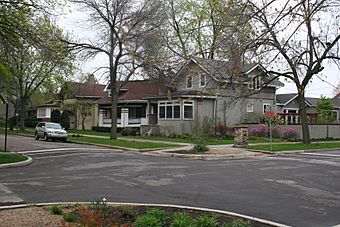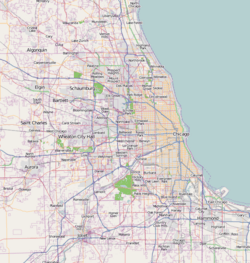Villa District facts for kids
|
Villa Historic District
|
|

Intersection of Springfield and Waveland Avenues
|
|
| Location | Chicago, Illinois, United States |
|---|---|
| Built | 1902; 1913 |
| Architect | Clarence Hatzfeld, Arthur Knox |
| Architectural style | Bungalow/Craftsman |
| NRHP reference No. | 79000830 (original) 83000316 (increase) |
Quick facts for kids Significant dates |
|
| Added to NRHP | 11 Sep 1979 (original) 10 Mar 1983 (increase) |
The Villa District, also known as the Villa Historic District, is a special area in Chicago, Illinois. It's called a historic district because it has many old and important buildings. This neighborhood is on Chicago's Northwest Side, within the Irving Park community.
The district's borders are Pulaski Road to the west and Hamlin Avenue to the east. To the north is the Union Pacific/Northwest rail line, and to the south is Addison Street. The Blue Line train's Addison station is nearby, making it easy to visit.
Contents
What Makes the Villa District Special?
The Villa District was mostly built in 1902. Many architects helped design the homes here. They were often inspired by the "Prairie Style" of architecture. This style was made famous by Frank Lloyd Wright.
Unique Homes and Design
A lot of the homes are bungalows. These were designed by the firm of Hatzfeld and Knox. One partner, Clarence Hatzfeld, also designed buildings at Portage Park. The area was first called the "Villa addition to Irving Park."
You can see many unique Craftsman and Prairie style homes here. They are built along pretty "boulevard style" streets. These streets have wide grassy areas and trees.
Nearby Landmarks
While visiting, you might see St. Wenceslaus church. It's a beautiful church with a mix of Romanesque and Art Deco styles. However, this historic church is actually a few blocks south of the Villa District's official boundaries.
A Famous Chicago Neighborhood
The Villa District was once known as the "northwest bookend" of Chicago's "Polish Corridor." This was a long stretch along Milwaukee Avenue where many Polish-American families lived.
The "Polish Kenilworth"
A famous journalist named Mike Royko gave the area a special nickname: the "Polish Kenilworth." Kenilworth is a very fancy suburb north of Chicago. Royko used this name to show that the Villa District was a nice, well-off area for Polish families.
Becoming a Historic Place
The Villa Historic District is officially recognized for its importance.
National Register of Historic Places
It was added to the National Register of Historic Places on September 11, 1979. This is a list of places in the United States that are important to history. On March 10, 1983, the district's area was made larger to include more buildings.
Chicago Landmark Status
The Villa District also became a Chicago Landmark on November 23, 1983. This means the city of Chicago officially protects its historic character.


